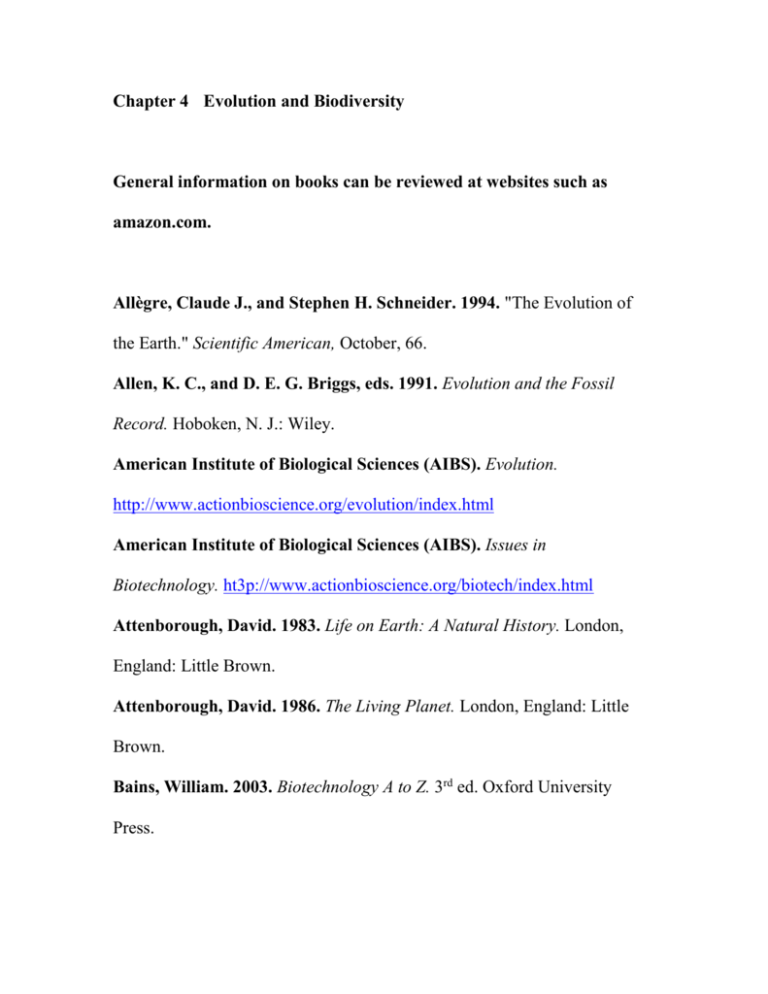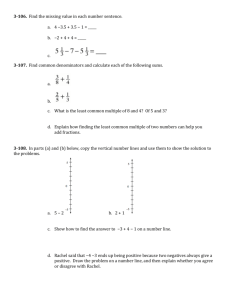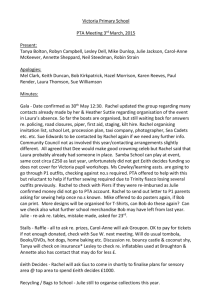Chapter 1
advertisement

Chapter 4 Evolution and Biodiversity General information on books can be reviewed at websites such as amazon.com. Allègre, Claude J., and Stephen H. Schneider. 1994. "The Evolution of the Earth." Scientific American, October, 66. Allen, K. C., and D. E. G. Briggs, eds. 1991. Evolution and the Fossil Record. Hoboken, N. J.: Wiley. American Institute of Biological Sciences (AIBS). Evolution. http://www.actionbioscience.org/evolution/index.html American Institute of Biological Sciences (AIBS). Issues in Biotechnology. ht3p://www.actionbioscience.org/biotech/index.html Attenborough, David. 1983. Life on Earth: A Natural History. London, England: Little Brown. Attenborough, David. 1986. The Living Planet. London, England: Little Brown. Bains, William. 2003. Biotechnology A to Z. 3rd ed. Oxford University Press. Baskin, Yvonne. 1998. The Work of Nature: How the Diversity of Life Sustains Us. Washington, D. C.: Island Press. Becoming Human. Journey Through the Story of Human Evolution. http://www.becominghuman.org/ Bell, William J., et al. 2007. Cockroaches: Ecology, Behavior, and Natural History. Baltimore, Md.: The Johns Hopkins University Press. Benton, Michael. J. 1995. "Diversification and Extinction in the History of Life." Science, vol. 268, 52. Benton, Michael J. 2005. When Life Nearly Died: The Greatest Mass Extinction of All Time. London: Thames & Hudson. Bonnicksen, Andrea L. 2002. Crafting a Cloning Policy: From Dolly to Stem Cells. Washington, D. C.: Georgetown University Press. Brain, Marshall. “How Evolution Works.” http://www.howstuffworks.com/evolution2.htm Borem, Aluzio, et al. 2003. Understanding Biotechnology. Upper Saddle, N. J.: Prentice-Hall. Brown, Bruce, and Lane Morgan. 1990. The Miracle Planet. Edison, N. J.: W.H. Smith. Center for Science in the Public Interest (CSPI). Biotechnology Project. http://cspinet.org/biotech/ Charlesworth, Brian. 2003. Evolution: A Very Short Introduction. New York: Oxford University Press. Chase, Jonathan M., and Mathew A. Leibold. 2003. Ecological Niches: Linking Classical and Contemporary Approaches. Chicago, Ill.: University of Chicago Press. Commoner, Barry. 2002. “Unraveling the DNA Myth.” Harper’s Magazine, February, 39. http://www.mindfully.org/GE/GE4/DNA-MythCommonerFeb02.htm Condie, K. C. and R. E. Sloan. 1998. Origin and Evolution of the Earth: Principles of Historical Geology. Upper Saddle River, N. J.: Prentice Hall. Coyne, Jerry A., and H. Allen Orr. 2004. Speciation. Sunderland, Mass.: Sinauer. Darwin, Charles. 1859. On the Origin of Species. New York: D. Appleton. Dawkins, Rihard. 1987. The Blind Watchmaker. New York: W. W. Norton. Dennett, Daniel C. 1996. Darwin’s Dangerous Idea: Evolution and the Meanings of Life. New York: Simon & Schuster. Diamond, Jared M. 2006. The Third Chimpanzee: The Evolution and Future of the Human Animal. New York: Harper Perennial. Donovan, S. K. and C. R. C. Paul, eds. 1998. The Adequacy of the Fossil Record. Hoboken, N. J.: Wiley. Ehrlich, Paul R. 2002. Human Natures: Genes, Cultures, and the Human Prospect. New York: Penguin. Ehrlich, Paul R., and Peter Raven. 1967. “Butterflies and Plants: A Study in Coevolution.” Evolution, vol. 18, 586. Eisler, Riane. 1988. The Chalice and the Blade: Our History, Our Future. New York: HarperOne. Eisley, Loren. 1959. The Immense Journey: An Imaginative Naturalist Explores the Mysteries of Man and Nature. New York: Vintage. Eldredge, Niles. 1994. The Miner's Canary: Unraveling the Mysteries of Extinction. Princeton, N. J.: Princeton University Press. Eldredge, Niles. 1997. Dominion. Berkeley: University of California Press. Exploratorium. Origins of Life. http://www.exploratorium.edu/origins/index.html Fortey, Richard. 1999. Life: A Natural History of the First Four Billion Years of Life on Earth. New York: Vintage. Fukuyama, Francis. 2003. Our Posthuman Future: Consequences of the Biotechnology Revolution. New York: Picador. Futuyma, Douglas J. 2005. Evolution. Sunderlnd, Mass.: Sinauer. Gene Information. Gene Almanac. http://www.dnalc.org/ Gould, Stephen Jay. 2002. The Structure of Evolutionary Theory. Cambridge, Mass.: Harvard University Press. Gould, Stephen Jay. 1992. Ever Since Darwin: Reflections in Natural History. New York: W. W. Norton. Hallam, A., and P. B. Wignall. 1997. Mass Extinctions and Their Aftermath. New York: Oxford University Press. Harth, Erich. 1990. Dawn of a Millennium: Beyond Evolution and Culture. New York: Penguin. Hazen, Robert M. 2005. Genesis: The Scientific Quest for Life’s Origin. Washington, D. C.: Joseph Henry Press. Hey, Jody. 2001. Genes, Categories, and Species: The Evolutionary and Cognitive Causes of the Species Problem. New York: Oxford University Press. Hooper, Judith. 2003. Of Moths and Men. New York: W. W. Norton. Horvitz, Leslie A. 2001. Complete Idiot’s Guide to Evolution. Indianapolis, Ind.: Alpha. Human Behavior & Evolution Society. http://www.hbes.com/ International Center for Technology Assessment (CTA). http://www.icta.org/ Keller, Evelyn F. 2002. The Century of the Gene. Cambridge, Mass.: Harvard University Press. Knoll. Andrew H. 2004. Life on a Young Planet: The First Three Billion Years of Evolution on Earth. Princeton, N. J.: Princeton University Press. Lamb, Simon, and David Sington. 2003. Earth Story: The Forces That Have Shaped Our Planet. Princeton, N. J.: Princeton University Press. Lane, Nick. 2003. Oxygen: The Molecule That Made the World. New York: Oxford University Press. Larson, Edward J. 2006. Evolution: The Remarkable History of a Scientific Theory. New York: Modern Library. Lavers, Chris. 2002. Why Elephants Have Big Ears: And Other Riddles from the Natural World. New York: St. Martin’s. Leakey, Richard, and Roger Lewin. 1993. Origins Reconsidered: In Search of What Makes Us Human. New York: Anchor. Leakey, Richard, and Roger Lewin. 1996. The Sixth Extinction: Patterns of Life and the Future of Humankind. New York: Anchor. Lemonick, Michael D., and Andrea Dorfman. 2002. “How Life Began.” Time, July 29. 43. Leslie, John. 1998. The End of the World: The Science and Ethics of Human Extinction. London: Routledge. Levin, H. L. 2007. The Earth Through Time. New York.: AIPI Levin, Simon. 2000. Fragile Dominion: Complexity and the Commons. New York: Basic Books. Lightman, Alan, et al, eds. 2004. Living With the Genie: Essays on Technology and the Quest for Human Mastery. Washington, D. C.: Island Press. Lovelock, James. 2000. The Ages of Gaia. 2nd ed. New York: Oxford University Press. Lovelock, James. 2000. Gaia: A New Look at Life on Earth. New York: Oxford University Press. Low, Bobbi S. 1999. Why Sex Matters: A Darwinian Look at Human Behavior. Princeton, N. J.: Princeton University Press. Lunine, Jonathan I. 1998. Earth: Evolution of a Natural World. New York: Cambridge University Press. MacArthur, Robert H. 1958. “Population Ecology of Some Warblers of Northeastern Coniferous Forests.” Ecology, vol. 39, 599. Margulis, Lynn. 2000. Symbiotic Planet: A New Look at Evolution. New York: Perseus. Margulis, Lynn.2002. Early Life. 2nd ed. Sudbury, Mass.: Jones and Bartlett. Margulis, Lynn, and Dorion Sagan. 2000. What Is Life? Berkeley: University of California Press. Margulis, Lynn, et al., eds. 2000. Environmental Evolution: Effects of the Origin and Evolution of Life on Planet Earth. 2nd ed. Cambridge, Mass.: MIT Press. Massey, Rachel. 2001. “Biotech: The Basics—Part 1” Rachel’s Democracy & Health News, #716, Jan. 18. http://www.rachel.org/bulletin/index.cfm?St=4 Massey, Rachel. 2001. “Biotech: The Basics—Part 2” Rachel’s Democracy & Health News, #717, Feb. 1. http://www.rachel.org/bulletin/index.cfm?St=4 Massey, Rachel. 2001. “Biotech: The Basics—Part 3” Rachel’s Democracy & Health News, #718, Feb. 15. http://www.rachel.org/bulletin/index.cfm?St=4 Massey, Rachel. 2001. “Biotech: The Basics—Final Part” Rachel’s Democracy & Health News, #719, Mar. 1. http://www.rachel.org/bulletin/index.cfm?St=4 Massey, Rachel. 2001. “Engineering Humans—Part 1” Rachel’s Democracy & Health News, #721, Mar. 29. http://www.rachel.org/bulletin/index.cfm?St=4 Massey, Rachel. 2001. “Engineering Humans—Part 2” Rachel’s Democracy & Health News, #720, Mar. 15. http://www.rachel.org/bulletin/index.cfm?St=4 Mayr, Ernst. 2002. What Evolution Is. New York: Basic Books. McKibben, Bill. 2004. Enough: Staying Human in an Engineered Age. New York: Holt Paperbacks. Mehlman, Maxwell J. 2003. Wondergenes: Genetic Enhancement and the Future. Bloomington: Indiana University Press. Montague, Tim. 2007. “Synthetic Biology—Genetic Engineering on Steroids.” Rachel’s Democracy & Health News, #895, Feb. 22. http://www.rachel.org/bulletin/index.cfm?St=4 Mulhall, Douglas. 2002. Our Molecular Future: How Nanotechnology, Robotics, and Genetics Will Transform the World. Amherst, N. Y.: Prometheus. Myers, Norman. 1997. "Mass Extinction and Evolution." Science, vol. 278, 597. Natural History Museum. London. http://www.nhm.ac.uk/ New York Times. Genetically Modified Organisms (Collection of Articles). http://www.nytimes.com/library/national/science/health/gm-index.html Palumbi, Stephen R. 2001. "Humans as the World’s Greatest Evolutionary Force." Science, vol. 293, 1786. Parker, Andrew. 2004. In the Blink of an Eye. New York: Perseus. Potts, Rick. 1997. Humanity's Descent: The Consequences of Ecological Instability. New York: Avon. Quammen, David. 2004. “Was Darwin Wrong?” National Geographic, November, 2. Raup, David M. 1992. Extinction: Bad Genes or Bad Luck.” New York: W. W. Norton. Ridley, Mark, ed. 2004. Evolution, 2nd ed. New York: Oxford University Press. Rothenberg, David, and Wandee J. Pryor, eds. 2004. Writing the Future: Progress and Evolution. Cambridge, Mass.: MIT Press. Routhgarden, Joan. 2006. Evolution and Christian Faith: Reflections of an Evolutionary Biologist. Washington, D. C.: Island Press. Ruse, Michael, and Ayne Sheppard. 2001. Cloning: Responsible Science or Technomadness? Amherst, N. Y.: Prometheus. Schopf, J. William. 2001. Cradle of Life: The Discovery of Earth’s Earliest Fossils. Berkeley: University of California Press. Schopf, J. William. 2002. Life’s Origin: The Beginnings of Biological Evolution. Princeton, N. J.: Princeton University Press. Schwartzman, David. 2002. Life, Temperature, and the Earth. New York: Columbia University Press. Smil, Vaclav. 2003. The Earth’s Biosphere. Cambridge, Mass.: MIT Press. Smithsonian Museum of Natural History. http://www.mnh.si.edu/ Southwood, Richard. 2004. The Story of Life. New York: Oxford University Press. Stauffer, Robert C. 1957. “Haeckel, Darwin, and Ecology.” Quarterly Review of Biology, vol. 32, 138. Stearns, Stephen C., and Rolf F. Hoekstra. 2005. Evolution.2nd ed. New York: Oxford University Press. Stock, Gregory. 2002. Redesigning Humans: Our Inevitable Genetic Future. Boston: Houghton Mifflin. Tattersall, Ian. 1996. The Fossil Trail: How We Know What We Think We Know About Human Evolution. New York: Oxford University Press. The Evolutionist. http://www.lse.ac.uk/Depts/cpnss/darwin/evo/index.htm Tyson, Neil D., and Donald Goldsmith. 2004. Origins: Fourteen Billion Years of Cosmic Evolution. New York: W. W. Norton. Walker, Sharon. 2006. Biotechnology Demystified. Columbus, Ohio: McGraw-Hill Professional. Ward, Peter D. 2002. Rivers in Time: The Search for Clues to Earth’s Mass Extinctions. New York: Columbia University Press. Ward, Peter D. 2001. Future Evolution: An Illuminated History of Life to Come. New York: W. H. Freeman. Ward, Peter D. 2004. Gorgon: Paleontology, Obsession, and the Greatest Catastrophe in Earth’s History. New York: Viking. Ward, Peter D. 2007. Under a Green Sky: Global Warming, the Mass Extinctions of the Past, and What They Can Tell Us About Our Future. New York: Collins. Ward, Peter D., and Donald Brownlee. 2004. Rare Earth: Why Complex Life is Rare in the Universe. New York: Springer-Verlag. Weiner, Jonathan. 1995. The Beak of the Finch: A Story of Evolution in Our Time. New York: Vintage, Weisman, Alan. 2007. The World Without Us. New York. Thomas Dunne Books. Wilson, Edward O. 1994. The Diversity of Life. New York: Penguin. Wilson, Edward O. 2002. The Future of Life. New York: Knopf. Zimmer, Carl. 2006. Evolution: The Triumph of an Idea. New York: Harper Perennial.








